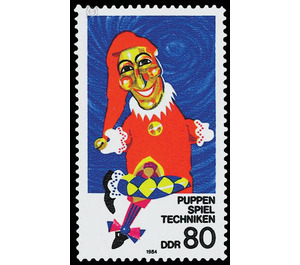puppet Theater - Germany / German Democratic Republic 1984 - 80 Pfennig
Theme: Art & Culture
| Country | Germany / German Democratic Republic |
| Issue Date | 1984 |
| Face Value | 80.00 |
| Color | red blue |
| Perforation | K 14 |
| Printing Type | Rotogravure 2 |
| Stamp Type | Postage stamp |
| Item Type | Stamp |
| Chronological Issue Number | 2619 |
| Chronological Chapter | GER-DDR |
| SID | 626583 |
| In 20 Wishlists | |
Theatrical dolls With the figures of theatrical dolls, the Ministry of Posts and Telecommunications of the German Democratic Republic issues two multicolored special postage stamps. Special stamps from June 5 to August 4 Puppet playing techniques The puppeteers across the world make use of certain leadership techniques that they have devised in the past and present to liven up their characters. The most common puppetry techniques are those for hand puppets, stick puppets, stick figures, puppets and shadow puppets, with the help of which silhouettes can be put on the screen. In addition, the players and ensembles, especially the state puppet theater in the socialist countries, use certain technical hybrid forms. With their help, figures can be moved in dimensions up to four meters. For a long time, stage directors of big scenes have used these theatrical possibilities and are using them in the interaction of human representation, mask and figure. The main actor on the puppet scene in the past was the "funny character". In Germany this u. a. Pickelhäring, Hanswurst, Kaspar and Kasperl, according to the models of the Viennese drama scene of the 18th and 19th centuries. Every nation with puppetry tradition has its funny person. To name just a few: Italy the "Pulcinella", Austria the "Kasper", France the "Guignol" and in Picardie the "Lafleur", England the "Punch", Denmark the "Meester Jackel", the Tsarist Russia the " Petrushka ", Czechoslovakia" Kasparek ", Hungary" Vitéz Läszlä ", Romania" Vasilache ", Greece and Turkey the" Karagöz ", India the" Vitusaka "and Indonesia the" Semar ", to name only the best known. Many of these figures can be seen in the puppet theater collection of the Dresden State Art Collection. Of course, the collection has a rich treasure of puppet characters of our territory. The oldest are from the end of the 18th century, the youngest from the present, because Kasper is still being asked to help in the GDR when it comes to dealing with problems with laughing mouths in interpersonal areas. 80 Pfennig value: The Handpuppenkasper Who does not know him, the funny journeyman who still asks the question before he begins his game: "Are you all there?". The children answer expectantly with a loud "yes". The oldest hand puppet puppet figures date from the early 19th century and belonged to the Dresden fairy-tale Kasper family Ganzauge. The figures are moved by hand, with most of the index finger stuck in the head of the figure, and middle finger and thumb exercise the arm movements of the doll. Each hand puppet player owns his punch, with which he fully identifies himself by playing himself. The present value was modeled after the Kaspers of the Lausitz puppet stage by Felix Lorenz, Großröhrsdorf. He was created by his daughter-in-law, the doll maker Konstanza Kavrakova-Lorenz. He is a figure of the present and proves that "Kasper" lives in our country. Felix Lorenz is an honorary member of UNIMA (Union Internationale de la Marionette), the international puppeteers organization that holds its XIV World Congress in Dresden this August (18th to 24th), to which more than 1,000 puppeteers are expected. Of course, our Kasper is in the Kulturpalast, because there is a special "Kasper-Treff" of players of funny characters from all over the world.


